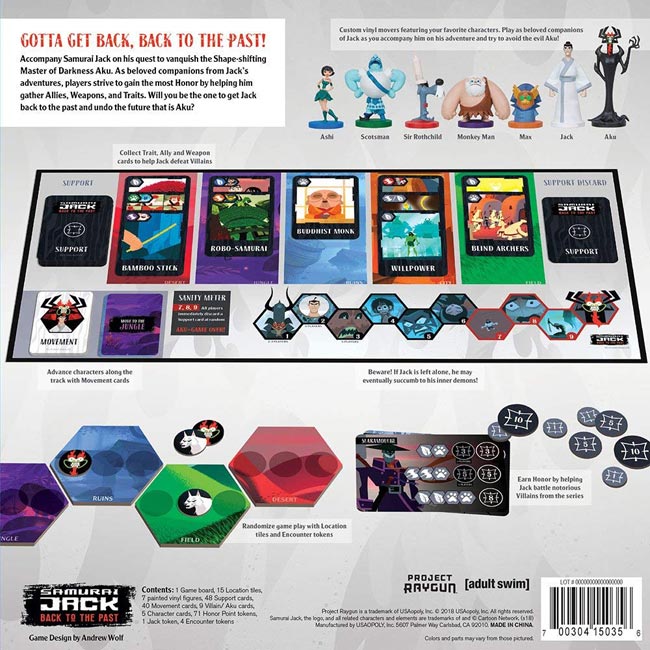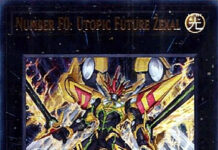 “Long ago in a distant land, I, Aku, the shape-shifting Master of Darkness, unleashed an unspeakable evil! But a foolish samurai warrior wielding a magic sword stepped forth to oppose me. Before the final blow was struck, I tore open a portal in time and flung him into the future, where my evil is law! Now the fool seeks to return to the past, and undo the future that is Aku!”
“Long ago in a distant land, I, Aku, the shape-shifting Master of Darkness, unleashed an unspeakable evil! But a foolish samurai warrior wielding a magic sword stepped forth to oppose me. Before the final blow was struck, I tore open a portal in time and flung him into the future, where my evil is law! Now the fool seeks to return to the past, and undo the future that is Aku!”
— Aku – Samurai Jack Opening Title Sequence
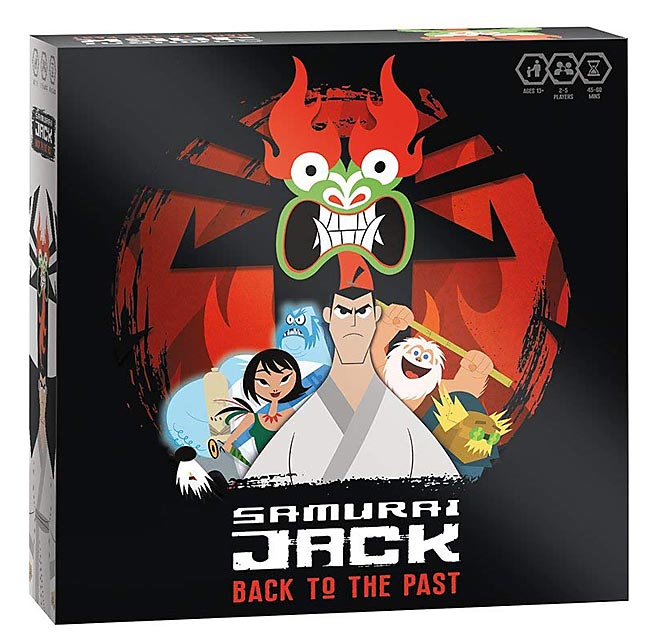
I used to watch Samurai Jack back in the early 2000’s with my kids. I was fascinated with the stories and the artwork. I can still recall being mesmerized watching an episode titled: “Jack and the Three Blind Archers“. The episode hardly had any dialogue … just beautifully drawn and crafted fight scenes, where Jack was trying to ascend to the top of a tower. The Three Blind Archers were using their exceptional hearing to mow down anyone and everyone who tried to get close to the tower. It is a fantastic episode to track down and watch if you have not seen it.
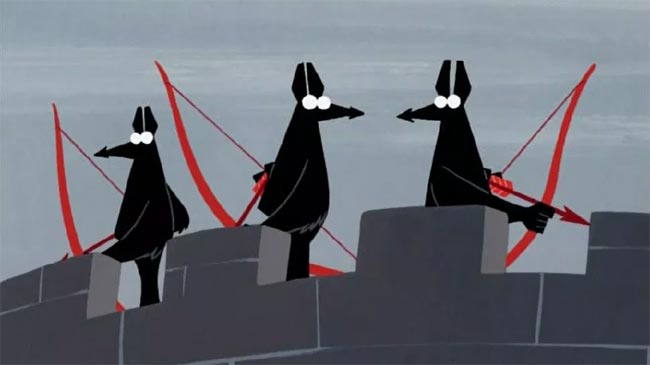
During the Gen Con 2018 Gaming Convention, I stopped by the USAopoly Booth to check out their new games. I saw some people demoing a new Samurai Jack game. I was kind of surprised to see Samurai Jack being used as a skin/theme as the show originally aired for 4 seasons from 2001 to 2005. I then found out there was a 5th season in 2017 that I never knew about. Now that my kids are grown up, I don’t watch Cartoon Network as much as I used to. 😉
The folks that were demoing the Samurai Jack game at GenCon appeared to be enjoying it. I watched them play for a while. The players said it was fairly easy to learn. So, I picked up a copy to play and review.
What’s in the box?
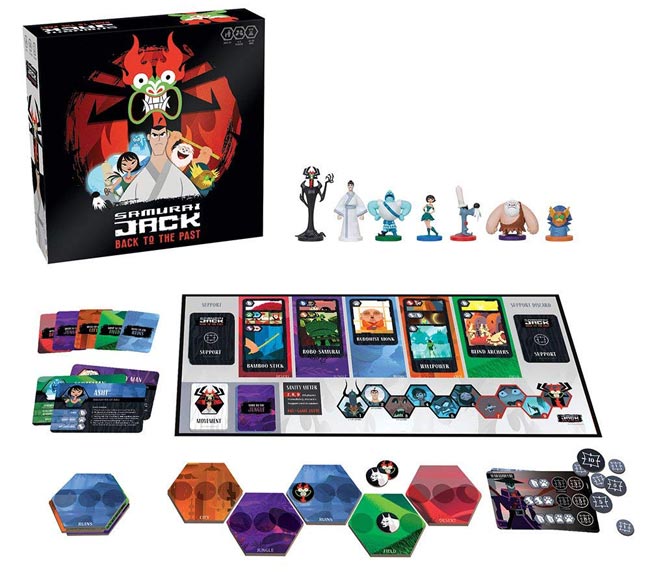
With this game you get:
- 15 Location Tiles – Hex Tiles
- 7 Painted Vinyl Figures
- 48 Support Cards – For Building your Battle Deck
- 40 Movement Cards – For moving yourself, Jack and Aku
- 5 Character Cards – a cheat sheet for how to play
- 9 Villain Cards
- Honor Tokens, Encounter Tokens, Jack Tokens
- Game Board – A Deck Board that is 22″ x & 10″ and holds all Support cards, and the Jack Sanity Meter Tracker
- Rulebook
How Do You Play Samurai Jack: Back the Past?
The goal of the game is to help Jack defeat Aku, and achieve the most honor in doing so. Aku is Jack’s main nemesis in the series.
The game is played with 2 to 5 players. Players take on the roles of Jack’s friends from the show: Ashi, The Scotsman, Monkey Man, Sir Rothchild or Max. These characters have no individual differentiating special powers. They are essentially just your player tokens to move around during the game.

I’m not really sure how to classify this game. I guess I would say it’s a fairly simple Racing/Deck-Building game. The game forgoes a traditional Racing-type game board for 15 cardboard Hex Tiles. You essentially snake the hex tiles around to make an S-curved Racing Track. The hex tiles represent 5 different locations: Jungle, Desert, Ruins, City and Fields. Players race around these hexagon tiles with Jack to fight the villains at the end of the road.
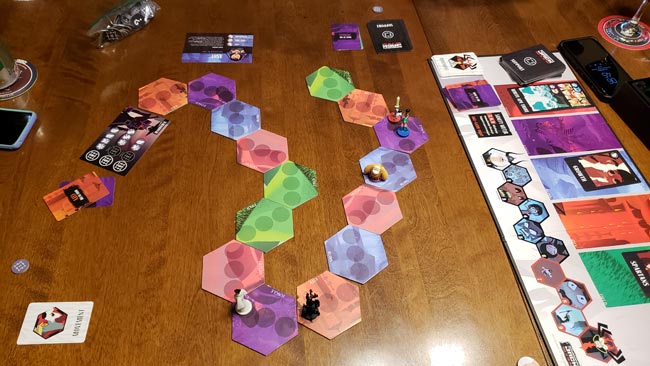
There are also Support Cards that are used to battle Jack’s villains at the end of the road. The Support Cards are used in the Deck-Building aspect of the game. Support cards are very basic. They have axes, leafs or paw prints on them. You collect Support cards when you land on hex tiles and bonus cards are awarded if you are on the same tile as Jack. You don’t get any Support cards though if Aku is on your tile.
Here is a very simple overview of the game.
Each player has 5 movement cards (matching the location tiles) to play. When you play a card, you move your player to that next area on the track. Jack and Aku’s movements are controlled by their a separate Jack/Aku movement Deck. Jack always moves first. All players move next – trying to stay close to Jack. And then Aku moves last.

After everyone moves, players grab Support Cards from the Game Board matching the location tile they are on. These Support Cards are used to make a very simple Battle Deck. This is the deck-building aspect to the game.
There is also a Sanity Meter for Jack. If players aren’t on the same tile as Jack, Jack gradually becomes more insane. If the Sanity Meter reaches the maximum level, all players lose.
Now you rinse and repeat moving Jack, all player’s tokens, and Aku. You simply can’t use a movement card that you have played already. When you reach the end of the road, you will battle a random villain from the Samurai Jack series.
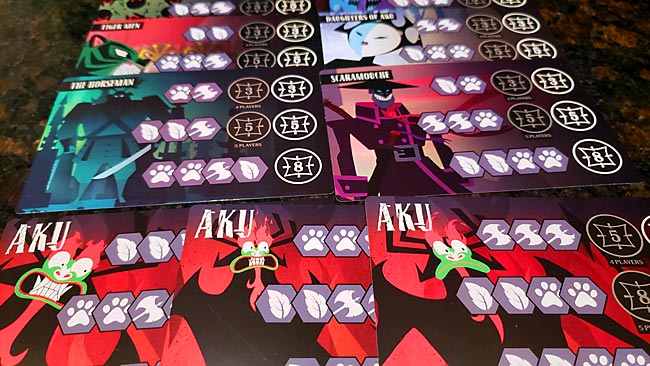
Once a player reaches the end of the track, that player will fight Jack’s first villain. Players need to discard cards from their Battle Decks to score honor. For example: you might have to defeat “The Horseman” (pictured above). To earn honor points, players will have to discard:
- 1 paw card and 1 axe card to earn 3 points
- 2 leaf cards and 1 axe card to earn 5 points
- or 2 paw cards, 1 axe card and 1 leaf card to earn 8 points.
Players occupy the spot on the Villain Card showing points they have scored. This prevents players lagging behind from scoring those points.
Once everyone has had a chance to battle the villains, you reset the hex tracks in a new random order. The 2nd time through, you battle another random villain. And the 3rd time through you will battle a random incarnation of Aku. The Game is now over.
The person with the most honor wins the game.
Pros and Cons
Pros:
- Beautiful Artwork and Figures – It’s nice to have painted, sculpted figures for this game. I recently reviewed Disney’s Villainous, and those figures are awful. The Support cards, villain cards, and the game board all have great art from the Samurai Jack series.
- Easy to Teach / Easy to Learn – When I see hexagon tiles in board games, I always envision a difficult game to learn and teach. This isn’t true here. This game is very easy to learn. The box says ages 13+. This game is teachable to ages 10+ in my humble opinion.
- Good Box Design – The Cover of the Box looks gorgeous. The game will look great sitting on a collector’s shelf. Also, the insert is well designed and holds all the pieces and cards perfectly.
- Simple, but fun choices – Do you want to keep up with Jack? Or explore an area to get a Battle card you need? Or race to the end and be the first to fight the villain? Which choice will net you more honor points in the end?
- 5 Players – Even with 5 players, the game doesn’t take too long and will play in less than an hour.
- Rulebook – The rulebook is listed as a pro and a con for me. I love that the rulebook is in full color. And I think the rules are very well explained here. Nothing confused me in the rules.
- Semi-Cooperative – If everyone gets too selfish in their gameplay (trying to get certain cards from the game board), and they leave Jack alone on the path, he will go insane and everyone will lose.
Cons:
- Game Board – I wish the game had a big game-board like Clank! or Ticket to Ride. I understand that using hexagon shaped tiles allow gamers to change how the game is played each time, but I’m not a fan. I feel like an opportunity was missed to make a beautiful folding game board. I would love to see a folding 20″ x 20″ gameboard with all three game stages already laid out for you. It would have been a great place for even more awesome Samurai Jack artwork, and would have removed the tediousness of laying out a track 3 times each game.
- Too Random – Aku’s movements throw a wacky curveball into the game. He can ruin your plans by landing on your hex tile, or by getting to the villain card first and taking away one of your battle options. I guess that’s what villains do.
- Simple Deck Building – The battle cards are simply leaves, axes and paws. There’s no cool Deck Building mechanic cards like you see in other Deck Building Games.
- You might not get to Battle Villains – If Aku gets to the end of the track first, he occupies the lowest scoring Honor Point Space on the Villain Card. If you are the last person to reach the end of the track, you will not get a chance to fight the villain. And you earn a big fat zero honor against the villain.
- Rulebook – I had the rulebook list as a Pro Too. The one con is that the rulebook folds out to be 3 feet wide. Try doing that at a small gaming table while looking up a rule. It is kind of like trying to read an ancient scroll. I wish it had been a normal 8-page rule booklet with staples at the crease.
Final Thoughts
The first time I played this game I was a bit disappointed. I didn’t get to fight the villain 2 out of 3 times, and I lost big time. I played the game too much like a deck-builder, and not enough like a racing game. I realized this was my fault, and changed my strategy the next time we played. This game is all about balance. You have to know: when to keep up with Jack; when to go for certain Support cards, and when to race to the Villains. The game grew on me with more play-throughs.
I feel this game is a great introductory game for getting new gamers and kids into board games, especially if they are Samurai Jack fans. The artwork is light and whimsical, and it’s super easy to teach. The game doesn’t take too long to play either.
If you are a Samurai Jack fan, this game might really appeal to you. As I said before, the Cover of the Box looks awesome, and the game will look great sitting on a collector’s shelf. The artwork and figures are great, and game play offers enough choices to make you use your brain. This gameplay might be too easy for gamers looking for a deeper strategy though.
